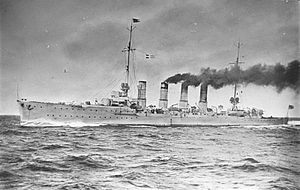Karlsruhe class
|
|
|
|---|---|
| Class details | |
| Ship type: | Small cruiser |
| Period of service: | 1914-1916 |
| Units: | 2 |
| Sister ships | |
|
SMS Karlsruhe SMS Rostock |
|
| Technical specifications | |
| Length: | over all: 142.2 m, waterline: 139 m |
| Width: | 13.7 m |
| Draft: | 6.7 meters |
| Displacement : | Construction: 4,900 t Maximum: 6,190 t |
| Drive: |
|
| Power: |
|
| Speed: | 28.5 kn |
| Range: | 5,000 nm at 12 kn |
| Fuel supply: | |
| Armament: |
|
| Armor: |
|
| Crew: | 373 men |
The Karlsruhe class was a series of small cruisers designed in 1910 for the Imperial Navy . There were only two of these units, both during the First World War were lost. In keeping with the tradition of the previous classes, they were given city names, such as Karlsruhe and Rostock .
draft
These ships hardly differed from their predecessors in the Magdeburg class . They were only slightly larger, with twelve 10.5 cm guns, had the same armament and armor. They also had four chimneys. Already with the next cruiser class one went back to three chimneys.
The main difference to the Magdeburg class was that these ships for the first time had, in addition to 12 coal-fired water-tube boilers, two oil-fired water-tube boilers. In addition, they were around 0.8 kn faster than their predecessors, as their turbine systems had an output of 1,000 PSw higher.
literature
- Erwin Strohbusch: Warship building since 1848 , German Maritime Museum, Bremerhaven 1984
- Erwin Strohbusch: Light cruiser from the years 1908 to 1918: II. The fleet cruisers // Marine Rundschau International 1981. - № 2.
